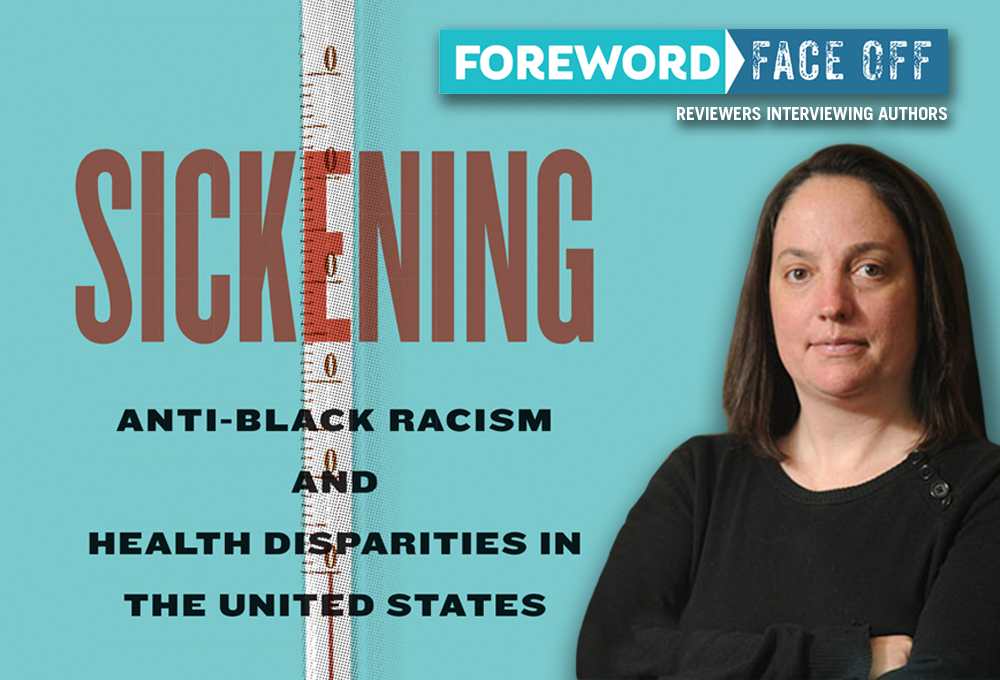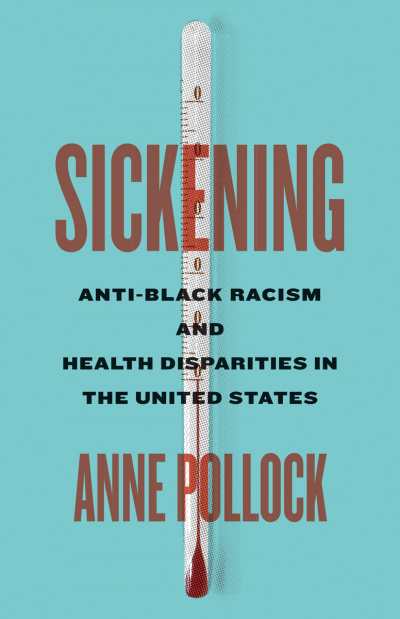Reviewer Letitia Montgomery-Rodgers Interviews Anne Pollock, Author of Sickening

Racism against Black people has changed from the days of Lincoln when racists had enslavement laws on their side. But one thing has never changed: then and now, anti-Black racism lives in the hearts of men—and that’s a difficult place to reach.

This week’s author, Anne Pollock, is an antiracist scholar, activist, and the new author of Sickening: Anti-Black Racism and Health Disparities in the United States, a brilliant investigation of how racism in the US has become structural and systemic, as well as personal. In her review of Sickening for the September/October issue of Foreword, Letitia Montgomery-Rodgers writes “a crucial guided analysis of anti-Blackness and its impact on Black people’s ability to live as fully entitled citizens, Pollock’s scholarship is essential medicine for a society in denial about its sickness.”
Anne, meet Letitia, who has some pressing questions on her mind.
You grew up in the United States but now live in the United Kingdom. Were there any challenges involved when writing about the US’s current/recent racist events while living abroad?
It has been an extraordinary time to be an American following events in the US from the outside. I’ve been thinking about the themes in this book for the past twenty years, and much of what I’ve written comes out of deep conversations with scholarly and activist communities in the United States—especially Atlanta, where I lived for ten years, from 2008 to 2018. Even now as travel has become more difficult, I remain in close contact with friends and colleagues there, many of whom read parts of the book manuscript in draft form. At the same time, I have also found it challenging in a really useful way to explain the book’s cases to British and other international audiences. When confronted with an egregious case from the book—such as the postal workers who died in the anthrax attacks, or the preferential treatment of General Motors machines over people in Flint—people here are much more likely to ask: why did that happen? Writing this book from a geographic distance has been helpful for honing critical distance, highlighting the specificity of the ways in which the present conditions in the United States are not normal, not inevitable, could and should be otherwise.
Racism is deeply rooted in US society, but there’s often a popular correlation between racism and enslavement or the Civil War or even the Jim Crow era. In your book, you take pains to address racism as a contemporary problem and one that’s happening at a systemic level. What’s the difference between “racism” and “systemic racism”? And why do you think it’s important to revamp our cultural imagination around racism and its role in our present world?
Racism broadly is about the hierarchical differentiation between groups that ascribes greater value to members of one group than to members of another. Racism exists in the minds of individuals, and that does matter, especially when the individuals are in positions of power—for example teachers, doctors, mortgage brokers, police. But as that list already starts to suggest, racism also exists in much larger systems: educational systems, medical systems, housing systems, criminal justice systems, and more. Racism doesn’t rise or fall on any one person’s attitude, and that’s why it’s so important to change not just minds but also to look critically at structures—how they have been set up, and how they can be changed.
At the same time, if we attend to structures that reinforce inequality without cultivating any countervailing sense of their contingency, that can be paralyzing. Both history and structure matter a great deal and we need to understand that, but racism is also a dynamic and emergent process, and so is anti-racism. So, for example, when I analyze the McKinney Pool Party incident—which people may remember from the viral videos of a police officer pinning down a teenage girl in a bikini—I attend both to the forms of segregation that are epitomised in the very idea of a home-owner’s association-owned pool in a prosperous Southern suburb, and to the creative ways in which artists responded and media was mobilised to decry the injustice.
Systemic racism in the United States affects so many facets of life. I’m hard pressed to think of anyone who wouldn’t benefit from expanding their understanding of the topic. Sickening combines elements of subject matter primer, case study, and social justice workbook in a way that invites beginners but doesn’t allow them to remain at that level for long. Who did you conceive of as your reader, and how did you choose and/or limit your audience to benefit the book’s focus?
When I was thinking about putting these cases together, the main readers that I had in mind were undergraduate students like those that I taught at Georgia Tech. Many were pre-medical students or other bioscience students, with little to no background in fields such as history or sociology, but a keen interest in learning more about the larger world in which they live and to which they hope to contribute. The conventional way of teaching about topics of racism and health—a narrative that worked chronologically from colonialism and slavery through to 20th century abuses such as the Tuskegee Syphilis study—turned out not to work very well.
First, it seemed to locate the problem in the past alone, such that students too often responded, I sure am glad I don’t live back then, when the US was racist! Second, it started from a place too remote for students to relate to. By offering 21st-century case studies—events that have taken place in undergraduates’ own lifetimes, often recognizable as similar to their own experiences—I hope that this book provides students a more accessible and concrete entrée into larger historical and structural themes. I do also aim to delve deeply enough into analyzing the cases that my scholarly colleagues in fields such as science and technology studies and sociology of race and racism will find the material engaging, too. I hope that aiming for readers with these different levels of background will also make the book accessible to other readers as well, including activists who might also seek to deepen and broaden their analysis of racism.
Questions about citizenship, its meaning, and who’s allowed its benefits have been a flashpoint throughout US history, and as recent year’s news cycles have made clear, that past isn’t behind us. Citizenship and who qualifies as a citizen is a key feature of Sickening‘s argument and is informed by Foucault’s ideas of biopower. Could you elaborate on the connection between of citizenry and biopower?
Yes, the question of who counts as a citizen is a central biopolitical question. For Foucault, biopolitics is about power that operates by “making live” and “letting die,” and there is a lot at stake in who counts as “the society that must be defended.” In a structurally unequal society, biopolitics—the question of whose life is fostered and whose life is neglected—operates in racially stratified ways. In the book, the intersections between biopolitics and citizenship are important in multiple chapters. For example, in the chapter about the increase in chronic disease after Hurricane Katrina, I argue that media framings of the overwhelmingly poor and Black communities most impacted by Katrina’s aftermath as “criminals” and as “refugees”—rather than as members of the American public—was inextricable from their abandonment by the state. In another chapter, about the preferential treatment given to General Motors’ engine plant and the disregard for Flint’s people in the Flint Water Crisis, I explore how it comes to be that a private company comes to be more able to make demands on the state than the human citizens can.
In the book’s introduction, you offer background information about yourself and mention that you’re a white woman writing about racism. Although it’s not Black or POC’s job to educate everyone else about racism, it’s also a common feature of systemic racism in academia and the publishing industry to norm white experiences and treat white people preferentially—sometimes, especially—when it comes to speaking about race. How do you square your own work and scholarship with the hard truths about systemic racism in your field(s)?
This is such an important question, because it’s vital that everyone committed to justice speaks out against racism, and yet it’s all too easy for the white voices in that conversation to take up all the space. For white anti-racist scholars, raising our own voices against injustice is important but not enough. One thing that I do in the book is to make clear in my writing that my voice is one among many, being very intentional with citational practices that recognize the expertise of Black scholars. I urge readers to do the same by including the imperative #CiteBlackWomen in “The Sickening Assignment,” which is a template for analysis that I provide in the book’s conclusion for readers who would like to use the tools from the book to develop their own case studies.
More broadly, I come from a background in intersectional activism, and I am constantly looking for ways to use my privileged access to open doors and grow the space of antiracist scholarship—and in a way that doesn’t just replicate myself but promotes Black scholars, too. This is foundational of all of the facets of the work I do as a professor—so not just in the classroom and as an advisor and mentor to students at all levels, but also as a peer reviewer and a journal editor, and as a participant in academic governance—and that’s part of doing the work of antiracism in the place I find myself.
While reading is an important start, starting an anti-racism book club isn’t an end-all, be-all to racism among white people. What’s your hope for readers after the last page of Sickening is read?
First off, I wouldn’t underestimate the importance of changing the ways that we think. I hope that readers are encouraged to think more slowly about the instances of injustice that we see in our social media feeds. Don’t be defeated and demoralized by the doomscroll, and instead maintain focus on the justice questions: what is the specific injustice here and where is it coming from? And so while it’s true that thinking isn’t a replacement for action, developing an engaged critical perspective can energise and foster additional action. In the book’s conclusion, I encourage readers of all backgrounds to look for ways that they can make an impact in whatever spaces they find themselves, whether that’s in medical settings, university settings, or community settings. Potential avenues for action will be different for different readers, depending on where they are situated, but all of us have work to do.
Letitia Montgomery-Rodgers
